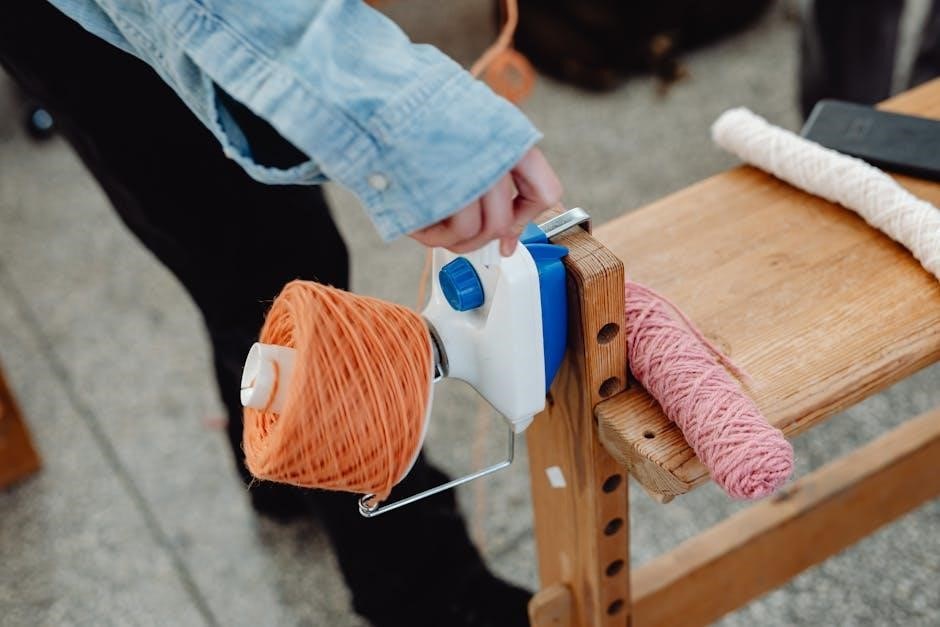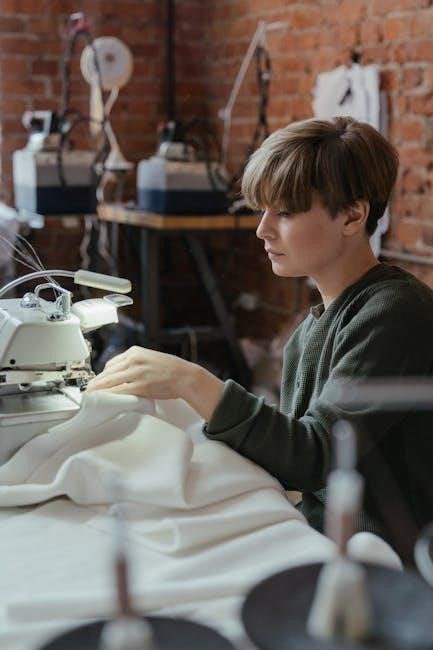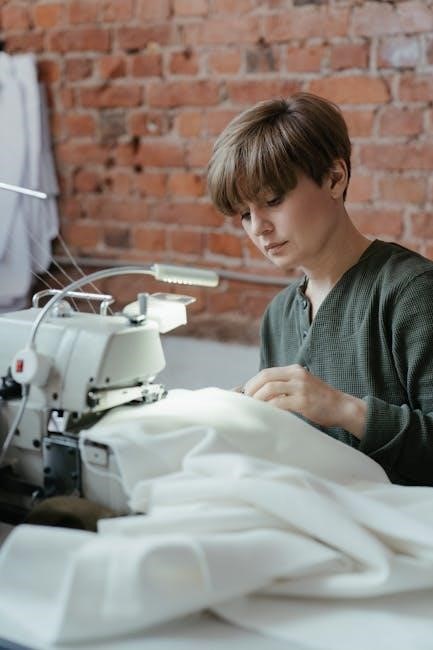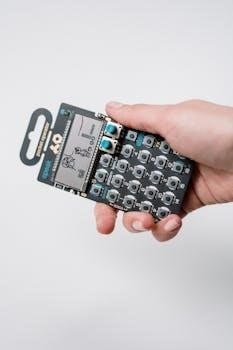Kenmore Mini Ultra Sewing Machine Manual: A Comprehensive Guide
Welcome to your comprehensive guide to the Kenmore Mini Ultra sewing machine! This guide will provide you with valuable information to operate and maintain your machine effectively․ From threading to troubleshooting‚ we’ll cover everything you need․ Get ready to unlock the potential of your Kenmore Mini Ultra!
The Kenmore Mini Ultra sewing machine is a compact and user-friendly option for both beginners and experienced sewers․ Its lightweight design makes it easily portable‚ perfect for small spaces or taking to sewing classes․ Despite its smaller size‚ it offers a range of features suitable for various sewing projects․
This machine typically includes basic stitches like straight stitch and zigzag‚ as well as options for decorative stitches‚ enhancing your creative possibilities․ Understanding the machine’s capabilities‚ including threading‚ bobbin winding‚ and tension adjustment‚ is crucial for optimal performance․ The Kenmore Mini Ultra is designed for ease of use‚ with clear instructions in the manual to guide you through each step․
Whether you’re mending clothes‚ creating crafts‚ or embarking on more complex sewing projects‚ the Kenmore Mini Ultra provides a reliable and convenient sewing experience․ Its simple operation and accessible manual make it a great choice for those new to sewing or anyone seeking a portable and efficient machine․ Regular maintenance‚ as detailed in the manual‚ will ensure its longevity and consistent performance․
Identifying Your Model: Why It Matters

Identifying the specific model number of your Kenmore Mini Ultra sewing machine is crucial for accessing the correct manual and resources․ Kenmore sewing machines‚ including the Mini Ultra‚ come in various models‚ each with unique features and specific instructions for operation and maintenance․ The model number is typically located on a nomenclature plate on the machine․
Using the wrong manual can lead to confusion and potentially damage your machine․ The correct manual provides detailed instructions on threading‚ bobbin winding‚ stitch settings‚ and troubleshooting‚ all tailored to your specific model․ Furthermore‚ identifying your model number allows you to find compatible replacement parts and accessories․
Websites such as Sears Parts Direct and sewing machine forums often require the model number to provide accurate information and support․ Knowing your model ensures you receive the right guidance for any repairs or adjustments․ It also enables you to find model-specific tutorials and videos that can enhance your understanding of your machine’s capabilities and ensure its long-term performance․
Accessing the Correct Manual: Online Resources
Finding the correct manual for your Kenmore Mini Ultra sewing machine is easier than you might think‚ thanks to numerous online resources․ Sears Parts Direct is a great starting point‚ offering free PDF manuals for many vintage Kenmore sewing machines․ Simply enter your model number into their search bar to access the manual specific to your machine․
Numerous other websites specialize in sewing machine manuals‚ providing both free downloads and printed copies․ These sites often have extensive libraries of Kenmore manuals‚ making it likely you’ll find the one you need․ Additionally‚ online sewing forums and communities can be valuable resources‚ where users share manuals and offer assistance in locating hard-to-find documents․
When downloading a manual‚ ensure it matches your model number to avoid incorrect instructions․ Saving the manual digitally allows for easy access on any device‚ while printing a hard copy provides a convenient reference guide for your sewing area․ Exploring these online resources ensures you have the correct information for operating and maintaining your Kenmore Mini Ultra sewing machine․

Threading the Machine: A Step-by-Step Guide
Threading your Kenmore Mini Ultra sewing machine correctly is crucial for smooth and successful sewing․ Begin by raising the presser foot lever to release tension on the thread․ Place your spool of thread on the spool pin‚ ensuring it unwinds correctly․ Guide the thread through the thread guide‚ following the numbered diagram often found on the machine itself․
Next‚ bring the thread down and around the tension disc‚ ensuring it sits snugly․ Then‚ guide the thread up to the thread take-up lever‚ threading it from right to left․ Bring the thread down again‚ guiding it through any remaining thread guides before threading the needle from front to back․
Always double-check that the thread is properly seated in each guide to avoid tangles and skipped stitches․ After threading the needle‚ draw a length of thread through the eye․ Gently pull the top thread to bring up the bobbin thread․ With both threads held together‚ you’re ready to start sewing!
Bobbin Winding: Ensuring Smooth Operation

Winding the bobbin correctly is essential for smooth and even stitches․ First‚ disengage the sewing mechanism by pulling out the handwheel․ Place an empty bobbin onto the bobbin winding spindle․ Position your thread spool on the spool pin and guide the thread through the thread guide specifically designed for bobbin winding․
Wind the thread around the bobbin a few times to secure it․ Then‚ push the bobbin winding spindle to the right to engage the winding mechanism․ Gently depress the foot pedal to start winding the bobbin․ Maintain a steady speed and avoid overfilling the bobbin‚ as this can cause issues during sewing․
Once the bobbin is full or reaches the desired level‚ the winding mechanism should automatically disengage․ If not‚ stop the machine manually․ Trim the thread and remove the full bobbin from the spindle․ Push the handwheel back in to re-engage the sewing mechanism․ Your bobbin is now ready for use‚ ensuring your Kenmore Mini Ultra operates smoothly․
Adjusting Thread Tension: Achieving Perfect Stitches
Achieving the perfect stitch with your Kenmore Mini Ultra relies heavily on proper thread tension․ If your stitches are too loose‚ forming loops on the fabric’s surface‚ the tension is likely too low․ Conversely‚ if the stitches are too tight‚ causing puckering or thread breakage‚ the tension is too high․

To adjust the thread tension‚ locate the tension dial on your machine․ This dial is usually marked with numbers․ Increase the number to tighten the tension and decrease it to loosen the tension․ Make small adjustments and test the stitch on a scrap piece of fabric after each adjustment․ Observe the stitch closely to determine if further adjustments are needed․
Ideally‚ the top and bottom threads should interlock evenly within the fabric layers․ If the top thread is visible on the underside‚ decrease the tension․ If the bobbin thread is visible on the topside‚ increase the tension․ Consistent practice and patience will help you master thread tension adjustments for flawless stitches with your Kenmore Mini Ultra․
Understanding Stitch Settings: Basic and Decorative
The Kenmore Mini Ultra sewing machine offers a variety of stitch settings to accommodate different sewing needs‚ ranging from basic utility stitches to decorative embellishments․ Understanding these settings is crucial for achieving desired results in your sewing projects․
Basic stitches typically include a straight stitch‚ used for seams and general sewing‚ and a zigzag stitch‚ suitable for finishing raw edges and creating buttonholes․ The stitch length and width can usually be adjusted to suit the fabric and application․
Decorative stitches add a creative flair to your projects․ Your Mini Ultra might include options like scallop stitches‚ satin stitches‚ or other ornamental patterns․ Experiment with different threads and fabrics to see how these stitches can enhance your designs․ Refer to your manual for a detailed explanation of each stitch and recommended settings․ By mastering these stitch settings‚ you can unlock the full potential of your Kenmore Mini Ultra and bring your creative visions to life․
Troubleshooting Common Issues: A Quick Fix Guide
Even with proper care‚ you may encounter occasional issues with your Kenmore Mini Ultra sewing machine․ This quick fix guide addresses some common problems and offers simple solutions to get you back to sewing․
One frequent issue is thread breakage․ This can be caused by incorrect threading‚ improper thread tension‚ or using the wrong type of needle for your fabric․ Ensure the machine is threaded correctly‚ adjust the tension as needed‚ and replace the needle with one suitable for your fabric․
Another common problem is skipped stitches․ This can occur if the needle is bent‚ dull‚ or not properly inserted․ Replace the needle and make sure it’s securely in place․ Also‚ check the bobbin is correctly inserted․ If fabric isn’t feeding through‚ clean the feed dogs and adjust the presser foot pressure․ For more complex issues‚ consult your manual or seek professional assistance․
Maintenance and Care: Oiling and Cleaning
Regular maintenance is crucial for extending the life and ensuring the smooth operation of your Kenmore Mini Ultra sewing machine․ Oiling and cleaning are essential aspects of this maintenance routine․
Oiling helps to keep the moving parts of your machine lubricated‚ preventing friction and wear․ Refer to your manual for specific oiling points․ Typically‚ these include the bobbin case area‚ needle bar‚ and other moving components․ Use only sewing machine oil and apply sparingly to avoid over-lubrication․
Cleaning removes lint‚ dust‚ and thread build-up that can interfere with the machine’s performance․ Regularly clean the bobbin area‚ feed dogs‚ and needle plate with a soft brush or lint brush․ Unplug the machine before cleaning․ For stubborn residue‚ use a lint-free cloth dampened with sewing machine oil․
Proper maintenance extends the machine’s life․
Finding Replacement Parts and Accessories
Over time‚ you may need to replace parts or acquire accessories for your Kenmore Mini Ultra sewing machine․ Knowing where to find these items is essential for keeping your machine in good working order․
Start by checking online retailers specializing in sewing machine parts․ Many websites offer a wide selection of parts and accessories specifically for Kenmore machines‚ including the Mini Ultra model․ Be sure to have your machine’s model number handy to ensure you order the correct parts․
Consider visiting local sewing machine repair shops․ These shops often carry a variety of replacement parts and accessories and can provide expert advice on which items are best suited for your needs․ They may also be able to order specific parts if they don’t have them in stock․
Explore online marketplaces and auction sites‚ where you might find used or vintage parts at competitive prices․ However‚ exercise caution when purchasing from these sources‚ and carefully inspect the items before buying․



